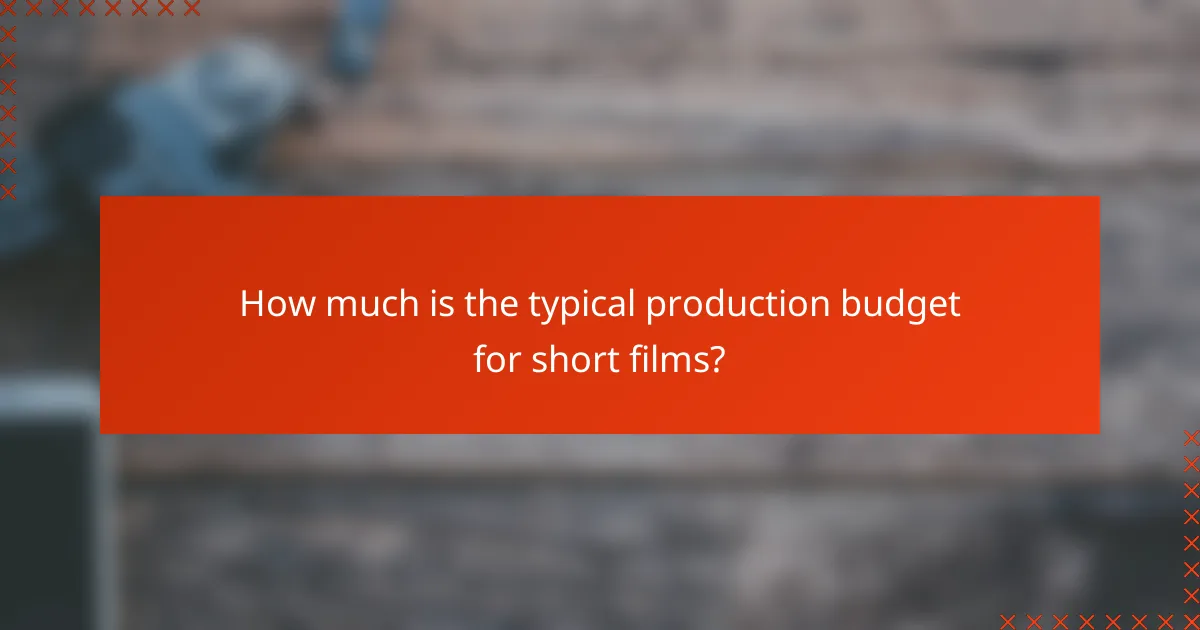Short films face various financial considerations, including festival fees, production budgets, and marketing expenses. Festival fees can range from $20 to several hundred dollars, influenced by the festival’s prestige and submission timing. Production budgets typically vary from a few hundred to tens of thousands of dollars, depending on factors like scope and crew size. Additionally, marketing expenses, which include social media advertising and promotional materials, play a crucial role in maximizing a film’s reach.

What are the festival fees for short films in major film festivals?
Festival fees for short films can vary significantly depending on the festival’s prestige and submission deadlines. Generally, fees range from around $20 to several hundred dollars, with early submissions often being cheaper than late entries.
Sundance Film Festival fees
The Sundance Film Festival typically charges submission fees that range from approximately $50 to $100 for short films, depending on the submission date. Early bird submissions are usually less expensive, while late entries can incur higher costs.
Filmmakers should also consider additional expenses such as travel and accommodation if selected, as Sundance takes place in Park City, Utah, which can be costly during the festival period.
Cannes Film Festival fees
For the Cannes Film Festival, submission fees for short films generally fall between €30 and €50. The festival has a prestigious reputation, so filmmakers should ensure their films meet the high standards expected by the selection committee.
In addition to the submission fees, filmmakers should budget for potential travel and accommodation expenses, as Cannes is a popular destination and prices can spike during the festival.
Toronto International Film Festival fees
The Toronto International Film Festival (TIFF) charges submission fees for short films that typically range from CAD 50 to CAD 100, depending on the submission window. Early submissions are encouraged to take advantage of lower fees.
As with other festivals, filmmakers should plan for additional costs related to travel and lodging, especially since TIFF attracts a large audience and industry professionals, making it a significant event in the film calendar.

How much is the typical production budget for short films?
The typical production budget for short films varies widely, generally ranging from a few hundred to several tens of thousands of dollars. Factors influencing the budget include the film’s scope, location, crew size, and production quality.
Low-budget short films
Low-budget short films typically have production costs under $10,000. These projects often rely on minimal crew, volunteer actors, and limited locations. Filmmakers frequently use personal equipment and seek grants or crowdfunding to support their efforts.
Common examples include student films or community projects, where the focus is on storytelling rather than high production values. Filmmakers should prioritize strong scripts and creative solutions to maximize impact on a limited budget.
Mid-range short films
Mid-range short films usually fall within the $10,000 to $50,000 budget bracket. These projects can afford a more experienced crew, better equipment, and potentially paid actors. Filmmakers in this range often seek funding through film grants, sponsorships, or small investors.
With a moderate budget, filmmakers can enhance production quality while still maintaining creative control. It’s crucial to allocate funds wisely across various aspects like casting, locations, and post-production to ensure a polished final product.
High-budget short films
High-budget short films generally exceed $50,000 and can reach into the hundreds of thousands. These films often feature well-known actors, professional crews, and advanced production techniques. They typically have access to substantial funding sources, including production companies or film festivals.
Filmmakers should focus on high-quality storytelling and production values to justify the investment. Networking with industry professionals and leveraging marketing strategies can help ensure the film reaches a wider audience, maximizing the return on investment.

What are the marketing expenses for short films?
Marketing expenses for short films can vary widely, but they typically encompass costs related to social media advertising, film festival submissions, and promotional materials. Understanding these expenses is crucial for budgeting and maximizing the film’s reach.
Social media advertising costs
Social media advertising costs can range from a few hundred to several thousand dollars, depending on the platform and campaign scale. Platforms like Facebook, Instagram, and Twitter offer targeted advertising options that can help reach specific audiences.
When planning your budget, consider allocating around 20-30% of your total marketing budget to social media ads. This allows for effective promotion while keeping costs manageable. Monitor ad performance regularly to optimize spending.
Film festival submission costs
Film festival submission costs can vary significantly, with fees typically ranging from $20 to over $100 per festival. Some prestigious festivals may charge even higher fees, while others may offer discounts for early submissions or student filmmakers.
It’s advisable to prioritize festivals that align with your film’s genre and audience. Create a list of target festivals and budget for submission fees accordingly, ensuring you account for potential multiple submissions to increase exposure.
Promotional materials expenses
Promotional materials expenses include costs for creating posters, flyers, and digital assets. Depending on quality and quantity, these costs can range from a few hundred to a couple of thousand dollars.
Investing in high-quality visuals is essential for attracting attention. Consider using online design tools or hiring a freelance designer to create compelling promotional materials. Allocate a portion of your marketing budget specifically for these expenses to ensure your film stands out.

What are the prerequisites for submitting short films to festivals?
To submit short films to festivals, filmmakers typically need to meet specific criteria set by each festival, including film length, genre, and submission deadlines. Understanding these prerequisites is crucial for ensuring eligibility and maximizing the chances of acceptance.
Film length requirements
Most short film festivals have strict length requirements, generally ranging from 1 minute to 40 minutes. However, many festivals consider films under 20 minutes as true short films, while those exceeding this may be categorized differently.
Filmmakers should check individual festival guidelines to confirm length limits, as some may have unique stipulations. For example, a festival might specify that films should not exceed 30 minutes, while others may accept longer entries if they are exceptional.
Genre specifications
Genre specifications vary widely among festivals, with some focusing on specific categories like documentary, animation, or horror. Filmmakers should align their submissions with the festival’s thematic focus to enhance their chances of selection.
It’s beneficial to research past selections to understand genre trends and preferences. For instance, a festival known for avant-garde films may not be the best fit for a traditional romantic comedy. Tailoring submissions to match the festival’s identity is essential for success.

What are the common funding sources for short films?
Common funding sources for short films include grants, crowdfunding, and private investors. Each option has its own advantages and challenges, making it essential for filmmakers to evaluate which source aligns best with their project goals and budget.
Grants for filmmakers
Grants are a popular funding source for short films, often provided by arts councils, film festivals, and non-profit organizations. These funds typically do not require repayment, making them an attractive option for filmmakers looking to minimize financial risk.
To secure a grant, filmmakers should carefully review eligibility criteria and submission guidelines. Many grants require a detailed project proposal, budget outline, and sometimes a sample of previous work. Researching and applying for multiple grants can increase the chances of receiving funding.
Crowdfunding platforms
Crowdfunding platforms like Kickstarter and Indiegogo allow filmmakers to raise money directly from the public. This method can be effective for generating funds while also building an audience for the film before its release.
Successful crowdfunding campaigns often feature compelling pitches, engaging rewards for backers, and a strong marketing strategy. Filmmakers should set realistic funding goals and timelines, as well as actively promote their campaigns through social media and personal networks.
Private investors
Private investors can provide significant funding for short films, often in exchange for a share of future profits or creative input. This source can be beneficial for filmmakers who have a clear vision and a solid business plan.
When seeking private investors, filmmakers should prepare a comprehensive pitch that includes a budget, timeline, and potential return on investment. Building relationships within the film industry can help filmmakers connect with potential investors who share their passion for storytelling.



